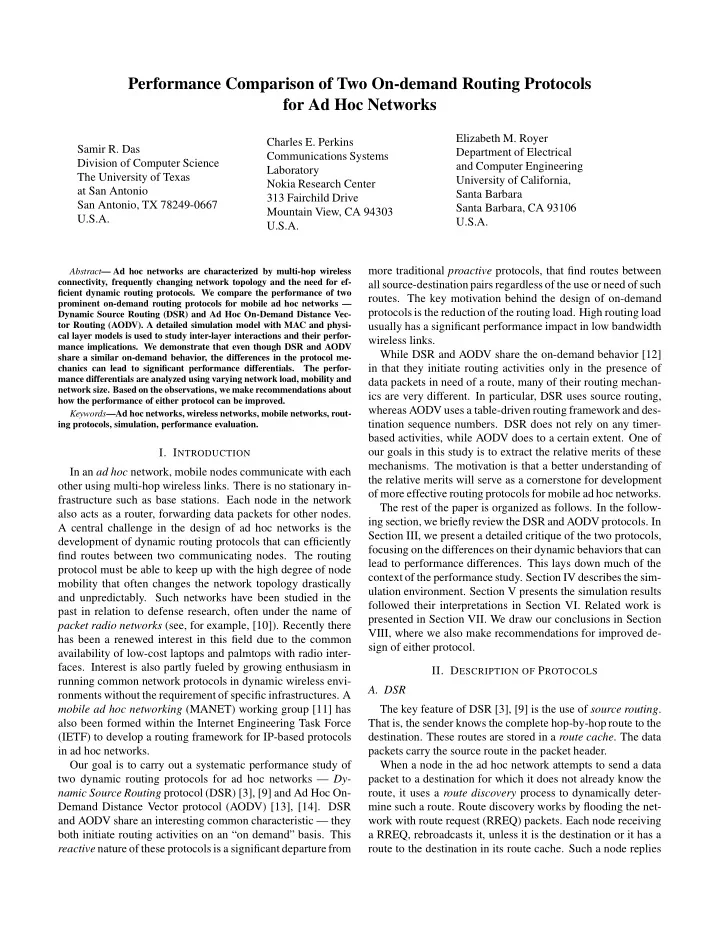

Performance Comparison of Two On-demand Routing Protocols for Ad Hoc Networks Elizabeth M. Royer Charles E. Perkins Samir R. Das Department of Electrical Communications Systems Division of Computer Science and Computer Engineering Laboratory The University of Texas University of California, Nokia Research Center at San Antonio Santa Barbara 313 Fairchild Drive San Antonio, TX 78249-0667 Santa Barbara, CA 93106 Mountain View, CA 94303 U.S.A. U.S.A. U.S.A. more traditional proactive protocols, that find routes between Abstract — Ad hoc networks are characterized by multi-hop wireless connectivity, frequently changing network topology and the need for ef- all source-destination pairs regardless of the use or need of such ficient dynamic routing protocols. We compare the performance of two routes. The key motivation behind the design of on-demand prominent on-demand routing protocols for mobile ad hoc networks — protocols is the reduction of the routing load. High routing load Dynamic Source Routing (DSR) and Ad Hoc On-Demand Distance Vec- tor Routing (AODV). A detailed simulation model with MAC and physi- usually has a significant performance impact in low bandwidth cal layer models is used to study inter-layer interactions and their perfor- wireless links. mance implications. We demonstrate that even though DSR and AODV While DSR and AODV share the on-demand behavior [12] share a similar on-demand behavior, the differences in the protocol me- chanics can lead to significant performance differentials. The perfor- in that they initiate routing activities only in the presence of mance differentials are analyzed using varying network load, mobility and data packets in need of a route, many of their routing mechan- network size. Based on the observations, we make recommendations about ics are very different. In particular, DSR uses source routing, how the performance of either protocol can be improved. whereas AODV uses a table-driven routing framework and des- Keywords —Ad hoc networks, wireless networks, mobile networks, rout- tination sequence numbers. DSR does not rely on any timer- ing protocols, simulation, performance evaluation. based activities, while AODV does to a certain extent. One of I. I NTRODUCTION our goals in this study is to extract the relative merits of these mechanisms. The motivation is that a better understanding of In an ad hoc network, mobile nodes communicate with each the relative merits will serve as a cornerstone for development other using multi-hop wireless links. There is no stationary in- of more effective routing protocols for mobile ad hoc networks. frastructure such as base stations. Each node in the network The rest of the paper is organized as follows. In the follow- also acts as a router, forwarding data packets for other nodes. ing section, we briefly review the DSR and AODV protocols. In A central challenge in the design of ad hoc networks is the Section III, we present a detailed critique of the two protocols, development of dynamic routing protocols that can efficiently focusing on the differences on their dynamic behaviors that can find routes between two communicating nodes. The routing lead to performance differences. This lays down much of the protocol must be able to keep up with the high degree of node context of the performance study. Section IV describes the sim- mobility that often changes the network topology drastically ulation environment. Section V presents the simulation results and unpredictably. Such networks have been studied in the followed their interpretations in Section VI. Related work is past in relation to defense research, often under the name of presented in Section VII. We draw our conclusions in Section packet radio networks (see, for example, [10]). Recently there VIII, where we also make recommendations for improved de- has been a renewed interest in this field due to the common sign of either protocol. availability of low-cost laptops and palmtops with radio inter- faces. Interest is also partly fueled by growing enthusiasm in II. D ESCRIPTION OF P ROTOCOLS running common network protocols in dynamic wireless envi- A. DSR ronments without the requirement of specific infrastructures. A mobile ad hoc networking (MANET) working group [11] has The key feature of DSR [3], [9] is the use of source routing . also been formed within the Internet Engineering Task Force That is, the sender knows the complete hop-by-hop route to the (IETF) to develop a routing framework for IP-based protocols destination. These routes are stored in a route cache . The data in ad hoc networks. packets carry the source route in the packet header. Our goal is to carry out a systematic performance study of When a node in the ad hoc network attempts to send a data two dynamic routing protocols for ad hoc networks — Dy- packet to a destination for which it does not already know the namic Source Routing protocol (DSR) [3], [9] and Ad Hoc On- route, it uses a route discovery process to dynamically deter- Demand Distance Vector protocol (AODV) [13], [14]. DSR mine such a route. Route discovery works by flooding the net- and AODV share an interesting common characteristic — they work with route request (RREQ) packets. Each node receiving both initiate routing activities on an “on demand” basis. This a RREQ, rebroadcasts it, unless it is the destination or it has a reactive nature of these protocols is a significant departure from route to the destination in its route cache. Such a node replies
Recommend
More recommend